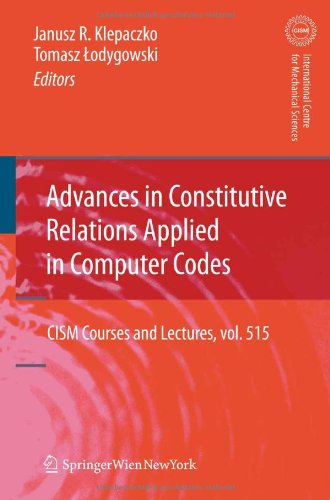

Most ebook files are in PDF format, so you can easily read them using various software such as Foxit Reader or directly on the Google Chrome browser.
Some ebook files are released by publishers in other formats such as .awz, .mobi, .epub, .fb2, etc. You may need to install specific software to read these formats on mobile/PC, such as Calibre.
Please read the tutorial at this link: https://ebookbell.com/faq
We offer FREE conversion to the popular formats you request; however, this may take some time. Therefore, right after payment, please email us, and we will try to provide the service as quickly as possible.
For some exceptional file formats or broken links (if any), please refrain from opening any disputes. Instead, email us first, and we will try to assist within a maximum of 6 hours.
EbookBell Team

4.0
66 reviews
ISBN 10: 3709110955
ISBN 13: 9783709110959
Author: Janusz R Klepaczko, Tomasz Lodygowski
1 Conaritutive relation (s) and numerical simulations
1.1 Purpose of numerical calculation
1.2 General remarks on constitutive relation (s)
2 The mechanical equation of state - concept and discussion
2.1 Preliminary remarks
2.2 General remarks on constitutive relations based on the MES
2.3 Adiabatic heating - a specific temperature history during plastic deformation
2.4 Most common examples of MES in explicit forms
References
3 The mechanical equation of state - concept and discussion
3.1 Introduction
3.2 The concept of the Mechanical Equation of State (MES) in RK constitutive relation
3.3 RK constitutive relation with rete and temperature dependent strain hardening
3.4 The intergration algorithm for FE calculation
3.5 Final discussion
References
4 Deviations from the MES hypothesis - deformation history effects
4.1 Rate and temperature sensitivities - general remarks
4.2 Instantaneous rate sensitivity and rate sensitivity of strain hardening
4.3 Some examples of strain rate history effects, FCC, HCP and BCC metals
4.4 Discussion and conclusions
References
5 Constitutive equations with evolution of strain hardening
5.1 Strain hardening by differential approximations
5.2 Strain rate and temperature effects by differential approximation
5.3 Phenomenological models with evolution of strain hardening - BP model
5.4 Phenomenological models with evolution of strain hardening - MTS model
5.5 Phenomenological models with evolution of strain hardening - modified MTS model
References
6 Dynamic failure criteria in tension, compression and shear - application to computer codes
6.1 Introduction
6.2 Dynamic fracture mechanics and dynamic failure mechanics
6.3 Fundamentals on time scale in fracture mechanics - loading rate spectrum
6.4 Models of failure based on evolution of mocro-cavities
6.5 Time and temperature dependent local fracture criteria
6.6 Cumullative criterion on spall fracture - effects of temperature
6.7 Effects of stress triaxiality on failure, fracture and spall
6.8 Faillure criterion for impact shearing
6.9 Concluding remarks
advances in political psychology
advances in consciousness research
advances in experimental political science
advances in politics and economics
constitutive relations in structural analysis
constitutive relations
Tags: Janusz R Klepaczko, Tomasz Lodygowski, Constitutive, Relations